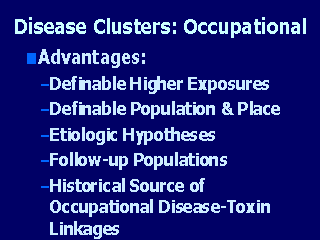|
|
|
|
front |1 |2 |3 |4 |5 |6 |7 |8 |9 |10 |11 |12 |13 |14 |15 |16 |17 |18 |19 |20 |21 |review |
 |
Disease clusters in the occupational setting, as opposed to the
traditional environmental or community cluster, do offer certain
advantages for their epidemiologic investigation.
Workplaces tend to have higher more definable exposures than communities. For example, the majority of allowable workplace chemical concentrations in the US are in the parts per million (ppm) while those for community exposure are in the parts per billion (ppb). The populations are often more uniform (i.e. healthy workers) and easily identifiable (such as personnel records). The geographic boundaries of a particular workplace are definable as opposed to those of a community and the risk of the Texas Sharpshooter bias. Etiologic hypotheses are easier to develop and substantiate due to existing exposure data (such as job titles or known job exposures). Appropriate follow up worker populations often exist worldwide due to the internationalization of industry. It should be noted that many of the disease-toxin linkages which are now an accepted part of the occupational and environmental literature were first discovered as occupational disease clusters. These range from male reproductive toxicity and the pesticide dibromochloropropane (DBCP) to angiosarcoma of the liver and vinyl chloride monomer exposure. |
|
|
|
|
front |1 |2 |3 |4 |5 |6 |7 |8 |9 |10 |11 |12 |13 |14 |15 |16 |17 |18 |19 |20 |21 |review |